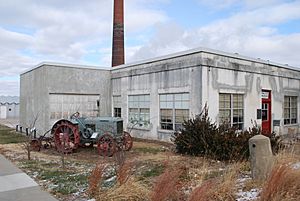Lester F. Larsen Tractor Museum facts for kids
 |
|
 |
|
| Established | 1980 |
|---|---|
| Location | 3310 Holdrege Street Lincoln, Nebraska |
| Type | Agriculture museum |
The Lester F. Larsen Tractor Test and Power Museum is a special museum in Lincoln, Nebraska. It tells the story of a famous state law called the Nebraska Tractor Test Law. This law makes sure that tractors sold in Nebraska are as powerful as the companies claim they are.
The museum is run by the University of Nebraska–Lincoln. It is located in the same building where tractors were first tested. It's the only museum in the world dedicated to tractor testing. It is also the only complete tractor test laboratory that you can visit.
Contents
A Law to Keep Tractors Honest
The story of the museum begins with a law passed way back in 1919. This law was created because of a farmer who was unhappy with a tractor he bought.
The Story of a Frustrated Farmer
In 1919, a farmer and state lawmaker named Wilmot Crozier bought a new tractor. The company advertised that it could pull three plows at once. But when Mr. Crozier used it, it could only pull one!
He found out that the tractor wasn't made by the famous Ford Motor Company. It was made by a different company called the Ford Tractor Company. This company just used the Ford name to trick people into buying their weak tractors.
Mr. Crozier wanted to protect other farmers from being tricked. He said, "I began wondering if there wasn't some way to induce all tractor companies to tell the truth." So, he helped create a new law.
The World's First Tractor Testing Lab
The new law was called the Nebraska Tractor Test Law. It said that any powerful tractor sold in Nebraska had to be tested first. The University of Nebraska–Lincoln was put in charge of the testing.
They built the Nebraska Tractor Test Laboratory in 1920. It was the very first place in the world designed to test tractors. The first tractor to pass the test was a Waterloo Boy Model N.
From Lab to Museum
The lab was used to test tractors for many years. In 1980, the testing moved to a new, modern building next door. The original building was turned into a museum in 1998.
It was named after Lester F. Larsen. He was the chief engineer at the lab for almost 30 years, from 1946 to 1975. The museum is now part of the University of Nebraska State Museum system.
How Tractors Are Tested Today
The University of Nebraska–Lincoln still tests tractors today. The test track is right next to the museum. Tractors are tested to see how much power they have for pulling things. This is called drawbar horsepower.
Inside the lab, a machine called a dynamometer measures the engine's power. The museum has the original dynamometer on display for visitors to see.
What's Inside the Museum?
The museum has a collection of about 40 special tractors. Many of them are antiques that show how farm machines have changed over time.
Some of the famous tractors you can see are:
- The Waterloo Boy Model N, which was the very first tractor to pass the Nebraska test.
- The Ford 8-16, the type of unreliable tractor that led Mr. Crozier to create the law.
- A Fordson from 1920.
- An Allis-Chalmers Model G.
- A Ford 8N, one of the most popular tractors ever made.
- A John Deere 820.


